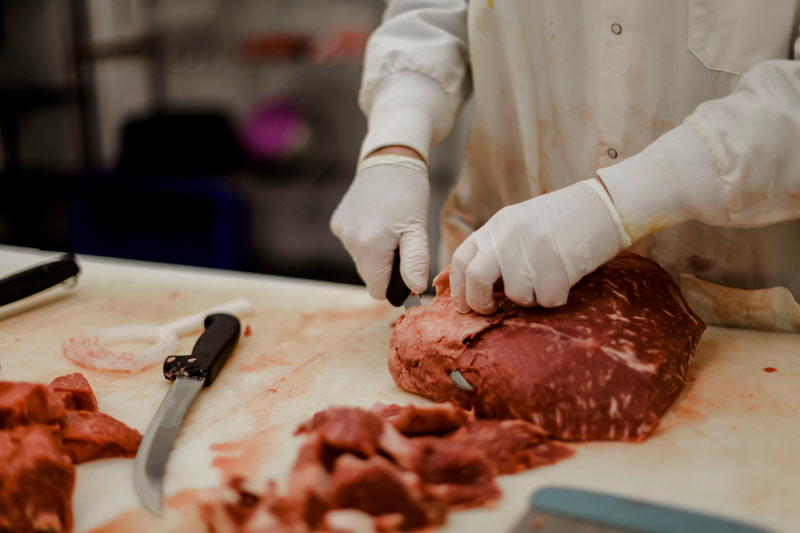Discover Fresh Cuts at Bagley Farms Meat Market Edwardsville IL for Your Next BBQ
Discover Fresh Cuts at Bagley Farms Meat Market Edwardsville IL for Your Next BBQ
Blog Article
Reveal the Art of the Butcher's Cut in a Modern Meat Market
In the ever-evolving landscape of modern-day meat markets, the butcher's cut has transcended its traditional roots, merging old-time workmanship with contemporary techniques. What absolutely sets the modern-day butcher apart is their ability to build a much deeper link between consumers and the origins of their meat.
Development of Butchery Techniques
The development of butchery methods reflects a rich tapestry of advancement and adaptation driven by improvements in innovation, changes in customer need, and a deeper understanding of meat science. Historically, butchery was a craft passed down via generations, with approaches developed over centuries to take full advantage of return and taste. However, the commercial change introduced automation, changing traditional methods and allowing large-scale handling.
The mid-20th century saw butchery methods better improved by clinical understandings right into muscular tissue biology and meat aging, improving both tenderness and preference. Innovations like vacuum cleaner product packaging and refrigeration extended product shelf-life, enabling butchers to branch out offerings and improve top quality control. This duration also noted the surge of specialized devices, such as band saws and meat slicers, which raised accuracy and effectiveness in meat handling.

Computerized systems now help in tracking pet provenance and enhancing cuts to fulfill certain client choices. Furthermore, a resurgence in artisanal butchery has actually emerged, mixing traditional skills with modern-day expertise to provide to customers looking for moral and lasting meat choices.
Comprehending Meat Cuts
Comprehending the ins and outs of meat cuts is crucial for both butchers and consumers seeking high quality and worth. Each cut originates from a various part of the pet, presenting distinct flavors, structures, and cooking techniques - bagley farms meat market edwardsville il. Proficiency of these differences not only boosts culinary experiences yet also makes the most of the utility of each carcass. For butchers, specific cuts mirror skill and respect for the craft, making sure minimal waste and optimum yield.

Recognizing muscle make-up is vital; muscular tissues made use of a lot more often by the pet often tend to be harder and are best matched for slow-moving cooking techniques, while less-used muscles, like those located in the loin, are extra tender and suitable for barbecuing or roasting. Knowledge with these differences encourages consumers to make informed selections, enhancing their cooking undertakings.
Choosing High Quality Meat
Picking the appropriate meat includes greater than simply choosing a visually More about the author appealing item from the display. bagley farms meat market edwardsville il. The art of choosing top quality meat needs a discerning eye and expertise of certain qualities that symbolize freshness and quality. Click This Link Pay attention to the shade; beef should have a brilliant, cherry-red shade, while lamb should exhibit a soft pink tone, and pork a pale pink. This indicates the meat is fresh and hasn't been exposed to oxygen for too long.
Second of all, think about the marbling, which refers to the white flecks of fat within the muscle. Appropriate marbling is a vital sign of tenderness and flavor, as it thaws throughout cooking, enhancing the meat's juiciness. Remember, higher marbling usually associates with premium quality cuts, such as USDA Prime.
Texture is one more vital aspect; meat needs to really feel strong to the touch, not slimed or extremely soft. In addition, be mindful of the scent. Fresh meat should have a clean, neutral smell, without any type of sour or off-putting odors.
Matching Cuts With Cooking Methods

On the other hand, harder cuts like brisket and chuck roast are rich in collagen, which breaks down into jelly when prepared slowly. These cuts are optimal for braising or slow-moving roasting, allowing the meat to tenderize gradually and create deep, complex flavors. Likewise, cuts such as brief ribs and pork shoulder make out well with slow-cooking methods, where prolonged cooking times transform their durable appearances right into delicious dishes.
Lamb shanks and oxtail, which require prolonged food preparation to soften, are best prospects for cooking or slow simmering. These methods coax out rich, hearty flavors while maintaining dampness. By recognizing the special qualities of each cut, cooks and home chefs alike can elevate their culinary productions, ensuring each recipe is both satisfying and memorable.
The Butcher's Function Today
Browsing the developing landscape of the modern meat market, the butcher's role today prolongs past mere preparation of cuts. Contemporary butchers are cooking artisans, teachers, and advocates for lasting techniques. They discover this connect the gap between the farm and the fork by guaranteeing moral sourcing, comprehending animal husbandry, and prioritizing openness in the supply chain. This shift reflects the expanding consumer demand for high quality over quantity, where provenance and pet well-being are paramount.
In enhancement to crafting exact cuts, butchers currently engage directly with clients, providing cooking suggestions and customizing selections to fit private needs and choices. Their competence in meat aging, marbling, and taste profiles empowers consumers to make enlightened decisions, boosting their cooking experiences. This individualized service exhibits the butcher's developing role as a relied on advisor in the kitchen area.
Moreover, butchers are pivotal in decreasing waste, using whole pets to produce varied products such as sausages and stocks. This extensive technique not only appreciates the animal however additionally aligns with contemporary sustainability objectives. By doing this, the modern butcher personifies both practice and technology, adapting to an ever-changing market while preserving the creativity and stability of their craft.
Verdict
Proficiency in comprehending diverse meat cuts and quality indications equips butchers to supply informed recommendations, straightening certain cuts with ideal cooking approaches. By honoring historic techniques while welcoming contemporary demands, the butcher's duty remains crucial in today's sophisticated meat market.
Report this page